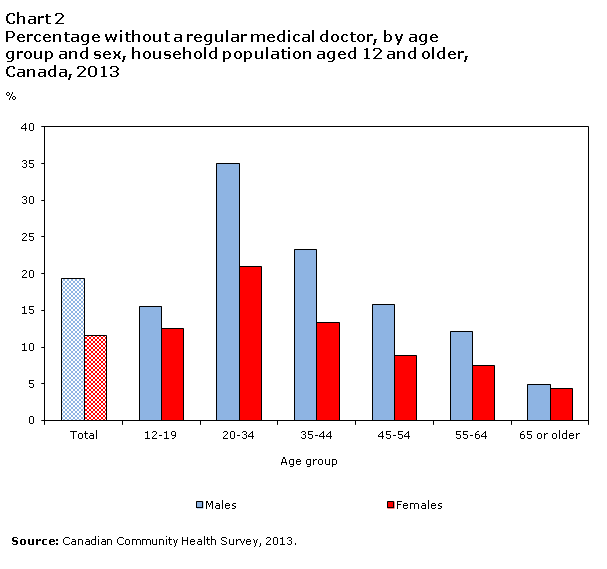Access to a regular medical doctor, 2013
Archived Content
Information identified as archived is provided for reference, research or recordkeeping purposes. It is not subject to the Government of Canada Web Standards and has not been altered or updated since it was archived. Please "contact us" to request a format other than those available.

For many Canadians, the first point of contact for medical care is their doctor. Being without a regular medical doctor is associated with fewer visits to general practitioners or specialists, who can play a role in the early screening and treatment of medical conditions.
In 2013, 15.5% of Canadians aged 12 and older, roughly 4.6 million people, reported that they did not have a regular medical doctor. The percentage of females who do not have a regular medical doctor increased from 10.1% in 2003 to 11.7% in 2008, and has remained unchanged since then. The rate for males has remained around 19.0% since 2003 (Chart 1).

Males and females aged 20 to 34 had the highest rate of being without a regular medical doctor. For males, the rate decreased with age starting at 20. The percentage of females without a regular medical doctor decreased between the ages 20 and 54, and again after age 64 (Chart 2).
In 2013, males were significantly more likely than females to report being without a regular doctor in all age groups from 12 to 64 years of age (Chart 2). There was no significant difference between males and females in the 65 or older age group.

The proportion of residents who were without a regular doctor was lower than the national average (15.5%) in:
- Newfoundland and Labrador (12.0%)
- Prince Edward Island (12.4%)
- Nova Scotia (9.7%)
- New Brunswick (8.0%)
- Ontario (8.8%)
The proportion of residents who were without a regular doctor was higher than the national average in:
- Quebec (25.1%)
- Saskatchewan (19.7%)
- Alberta (20.0%)
- YukonNote 1 (26.7%)
- Northwest TerritoriesNote 1 (58.1%)
- NunavutNote 1 (84.6%)
Residents of Manitoba and British Columbia reported rates that were about the same as the national average.
In 2013, the most common reason respondents gave for not having a regular doctor was that they had not looked for one (47.6%). Among those who had looked for a doctor, 37.6% said that doctors in their area were not taking new patients, 29.7% said that their doctor had retired or left the area, 25.2% said that no doctors were available in their area and 21.2% gave other reasons. (These add up to more than 100% because respondents could choose more than one reason for not having found a regular medical doctor.)
Of the 4.6 million Canadians without a regular doctor in 2013, 80.6% reported that they had a usual place to go when they were sick or in need of health advice. When they needed medical care, 58.9% reported using a walk-in clinic, a decrease from 2010 (61.8%); another 13.0% visited a hospital emergency room, about the same since 2009; while 8.7% used a community health centre or, in Quebec, a centre local de services communautaires, unchanged since 2008. The remaining 19.3% reported using other facilities such as appointment clinics, doctors’ offices, hospital out-patient clinics and telephone health lines.
End notes
References
Nabalamba, Alice and Wayne Millar. 2007. Going to the doctor. Health Reports, 18(1): 23–35.
Carrière, Gisèle. 2005. Consultations with doctors and nurses. Health Reports, 16(4): 45–48.
Tjepkema, Michael. 2008. Health care use among gay, lesbian and bisexual Canadians. Health Reports, 19(1): 53–64.
Data
Additional data from the Canadian Community Health Survey are available from CANSIM table 105–0501.
- Date modified:
